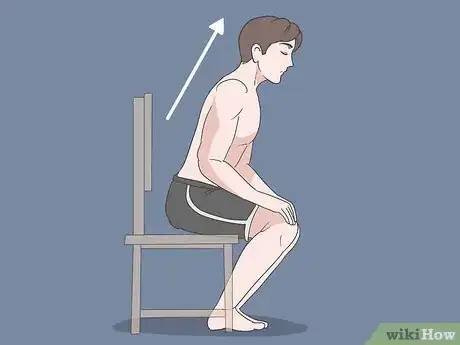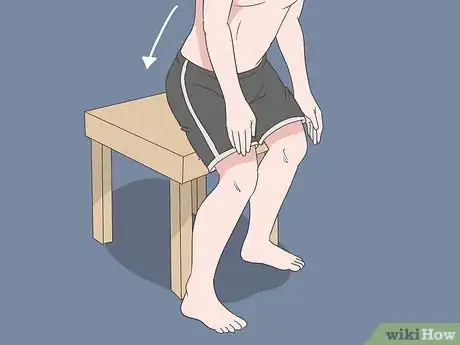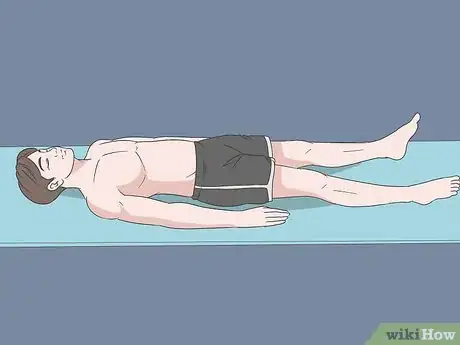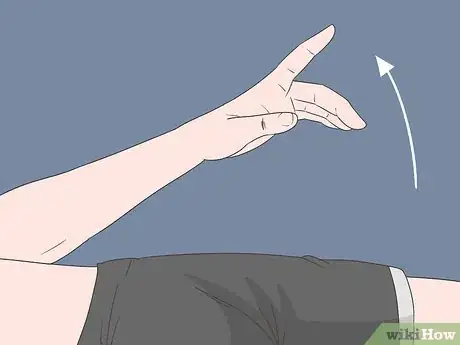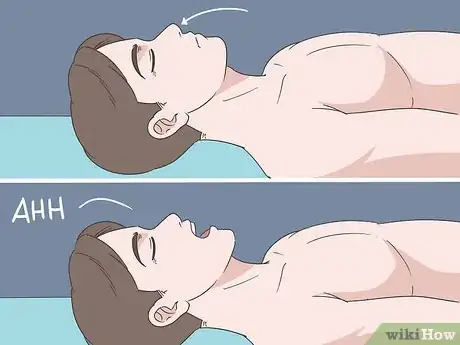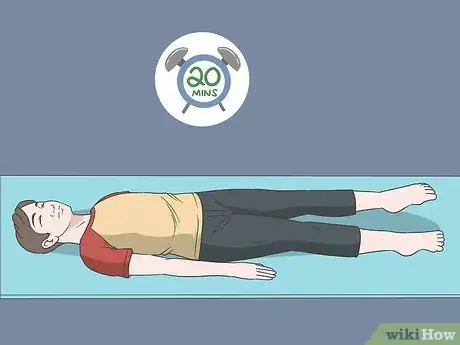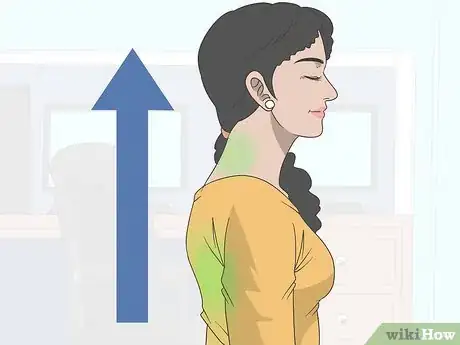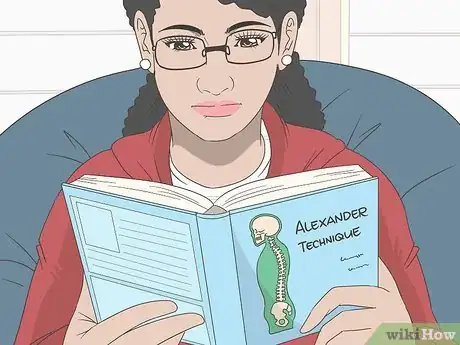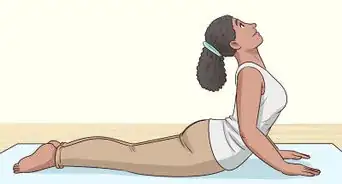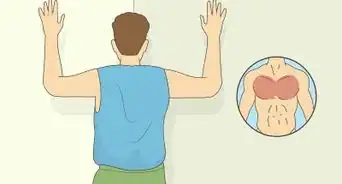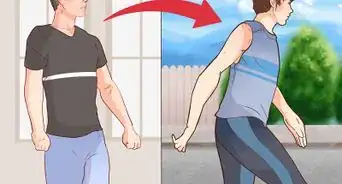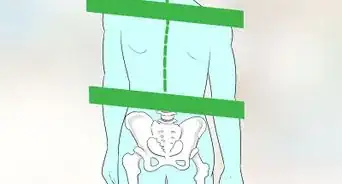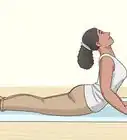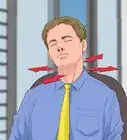This article was co-authored by wikiHow Staff. Our trained team of editors and researchers validate articles for accuracy and comprehensiveness. wikiHow's Content Management Team carefully monitors the work from our editorial staff to ensure that each article is backed by trusted research and meets our high quality standards.
This article has been viewed 21,046 times.
Learn more...
The Alexander Technique is a way of moving your body that helps to release tension and improve your posture, teaching you to stop the bad habits you might have when it comes to how you hold your body. The best way to learn the technique is by taking a class taught by a professional, but there are also lots of books you can read or online articles to peruse that will teach you the technique as well. Try doing exercises like sitting, standing up, or lying down, following the specific Alexander technique method.
Steps
Practicing Alexander Technique Exercises
-
1Stand up by focusing your movement on your hip joints. Standing up using this technique starts with sitting down. Release any tension you’re feeling in your shoulders or neck and place your feet flat on the ground. Move forward so your weight is over your feet, using your hip joints. Push down into your feet while standing up straight. Practice standing up from a sitting position 5-10 times before taking a break.[1]
- Practice doing this several times a day to get better at it and work on releasing unnecessary tension.
-
2Sit down in a chair to help you reduce tension in your legs. Start by standing up, making sure your knees are slightly bent and not locked straight. When you go to sit down, move your knees forward while your hips go backwards. Be careful not to sit down too quickly into the chair, taking the time to slowly lower yourself into a seated position. Do this exercise 5-10 times to help reduce tension.[2]
- This technique keeps you from plopping down in chairs, preventing extra pressure from being put on your neck, spine, and bottom.
Advertisement -
3Practice constructively resting by lying on a hard surface. Instead of using a bed or soft couch, lay down on a floor covered by a rug or a yoga mat. When you’re laying on the floor, place your feet flat on the ground with your hands either by your side or on your stomach. Rest like this for 10-15 minutes.[3]
- Consider resting your head on a thin pillow or small stack of books to make it easier on your neck or head.
- Do this exercise 2-3 times a day to help elongate your back and release tension.
-
4Lift your fingertips into the air to release tension from them. Start by placing your hands down by your sides. Instead of lifting your hand as you normally might, focus on only lifting up your fingertips. Bring your fingertips up into the air, trying to only use those muscles. This keeps you from using the bigger muscles in your hands and teaches you to release the tension in your fingers.[4]
- This exercise is great if you work at a keyboard all day or your fingers tend to feel cramped.
- Try doing this exercise several times a day in your free time.
-
5Whisper “ahh” to practice controlling your breathing. After you inhale, practice whispering “ahh” as you exhale. Try to make your exhale last at least 2 seconds longer than your inhale to help reduce stress and relax your muscles. When you’re exhaling, open your mouth comfortably to let the air escape naturally.[5]
- Do this as many times as you’d like, using the technique to help you calm down or even fall asleep.
-
6Do Alexander technique exercises for 20 minutes a day. Once you've learned a few movements from the technique, try setting a schedule where you practice the Alexander technique for 20 minutes each day. This will help you see results in your posture while also helping you improve your techniques and exercises.[6]
- Set a timer for 20 minutes to help you stay on track for your 20-minute goal.
Studying the Alexander Technique
-
1Use the technique to release tension and use your muscles efficiently. The Alexander technique focuses on teaching your body how to move in a more efficient way that gets rid of tension and improves your posture. The technique uses movements such as standing up, sitting down, walking, or lying down to teach you to be aware of the way you move throughout the day.[7]
- For example, if you notice that your neck or back tends to hurt after you’ve been in a certain position for too long, doing Alexander techniques that pinpoint the neck and back are a great way to reduce this pain or tension.
-
2Read books on the technique for details about research and practices. There are many books written on the Alexander technique from experts who have studied it as well as people who teach the method to others. Visit your local library or go online to find books that will teach you different exercises for the technique, or look for books telling you about the research that’s been done showing how the technique is beneficial.[8]
- Popular books on the Alexander technique include “How You Stand, How You Move, How You Live” by Missy Vineyard, “The Use of the Self” by F. Matthias Alexander, or “Body Learning: An Introduction to the Alexander Technique” by Michael J. Gelb.
-
3Take a class on the technique to learn from a professional. Taking a class to learn the Alexander technique is beneficial because you’ll be receiving hands-on practice and demonstrations. Professional instructors teach small groups as well as 1-on-1 classes, observing your movements so they can tell you how to improve. As you move your body for each exercise, they’ll use a light touch to guide you when necessary.[9]
- Go online to see if there are qualified teachers in your area who teach the Alexander technique in small groups or 1-on-1.
- Many professional Alexander technique organizations publish lists to help you find qualified teachers.
- These lessons can last anywhere from 30 minutes to 1 hour.
-
4Watch YouTube videos on the technique to learn it for free at home. If you don't want to pay for lessons by a professional but still want some visual guidance in learning the Alexander technique, try watching videos teaching you the movements. Type something like, "how to do the Alexander technique at home" into your search engine or YouTube to find helpful videos.[10]
- Look for videos from a reliable source, such as a professional who says they teach the Alexander technique in classes, or someone who has written a book on the technique.
References
- ↑ http://www.markjosefsberg.com/alexander-technique-exercises-2/
- ↑ http://www.markjosefsberg.com/alexander-technique-exercises-2/
- ↑ http://ergonomictrends.com/alexander-technique-exercises-posture-back-pain/
- ↑ http://ergonomictrends.com/alexander-technique-exercises-posture-back-pain/
- ↑ http://ergonomictrends.com/alexander-technique-exercises-posture-back-pain/
- ↑ http://ergonomictrends.com/alexander-technique-exercises-posture-back-pain/
- ↑ http://ergonomictrends.com/alexander-technique-exercises-posture-back-pain/
- ↑ https://www.theguardian.com/lifeandstyle/2007/mar/10/healthandwellbeing.shopping
- ↑ https://www.nhs.uk/conditions/alexander-technique/
